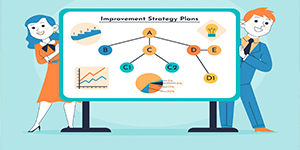How to Use Gamification to Evaluate Candidate Skills
Gamification in recruitment has developed as one of the most inventive and effective ways for identifying the suitable candidates in the ever-changing field of human resources and talent acquisition. This concept has emerged as a result of the fact that recruitment is constantly evolving. Gamified assessment tools, are becoming increasingly popular among recruiters as the hiring process becomes increasingly data-driven and digital. These tools allow recruiters to evaluate candidates in a way that is both immersive and enlightening. However, what are some ways that corporations might use gamification to evaluate candidate skills? The purpose of this article is to provide HR directors who are interested in modernizing their hiring method with practical insights by examining the fundamentals, tools, techniques and benefits of recruitment gamification.
 |
Understanding Gamification in RecruitmentAt its foundation, the term "gamification in recruitment" refers to the idea of incorporating elements of game design into the process of acquiring new employees. These features include points, levels, prizes, and challenges. Employers utilize talent assessment games to analyze a candidate's competences, behaviors, and decision-making abilities in an interactive manner. This is in contrast to the traditional assessment methods of interviews or written examinations, which are the only methods that are used. |
Motivation, engagement, and competition are three psychological principles that are utilized in this technique. Recruitment gamification enables human resource teams to obtain relevant behavioral data that standard evaluations frequently fail to capture. This is accomplished by completely altering the candidate experience into something that is both immersive and enjoyable.
Why Gamification Works in Candidate Skill Evaluation
It is often difficult for traditional methods of hiring to discriminate between applicants who perform well in interviews and those who perform well in situations that are more representative of the real world. The candidate skill evaluation through the use of gamification helps to bridge this gap by concentrating on how applicants think, behave, and react to challenges rather than how they characterize their capabilities.
An example of a gamified assessment tool would be one that presents a candidate with a simulated work challenge, such as managing a project while adhering to time limitations or handling a virtual customer complaint. This would be done in order to evaluate the candidate's ability to solve problems. Recruiters are able to get profound insights into the candidate's cognitive, emotional, and interpersonal skills through the use of these interactive activities, which are conducted in an environment that is far less scary to the candidate.
Additionally, gamification techniques for hiring top talent are particularly appealing to younger generations that are joining the workforce to begin with. Candidates who are members of the Millennial and Gen Z generations are digital natives who place a high value on experiences that are guided by technology and interactive. Processes that are gamified resonate with their expectations, which helps businesses develop stronger employer brands while also guaranteeing that candidate skill evaluations are more accurate.
How to Use Gamification to Assess Candidate Skills
In order for human resources personnel to successfully apply hiring with gamification process, they need to follow an organized approach. Listed below are the main actions that must be taken in order to build, and implement gamified assessment tools that are in line with the objectives of the organization.
1. Define the Skills and Competencies to Measure
It is important for human resource professionals to first determine the essential abilities, and behaviors that are necessary for success in a career before incorporating gamification in recruitment process. These may include technical expertise, the capacity to solve problems, creativity, the ability to work well with others, adaptability, or leadership.
Puzzles that evaluate logical reasoning, debugging tasks, and virtual code simulations are some examples of the types of talent assessment games specifically for software engineering purposes. On the other hand, a game-based approach to sales recruitment can entail role-playing situations involving customer encounters or negotiations.
2. Choose the Right Gamified Assessment Tools
The next step is to choose or create the right gamified assessment tools with the relevant features. Today, there are many different kinds of tools available, including the following:
-
The term "scenario-based simulations", refers to simulated circumstances that are based on real-world work issues.
-
Games of cognitive capacity are brief, fast-paced activities that test a person's memory, ability to recognize patterns, and reasoning skills.
-
The purpose of behavioral games is to evaluate emotional intelligence, decision-making, and leadership skills through interactions that are guided by a story.
-
Competitors fight against one another, or work together in skill-based events which are characterized by a leaderboard-driven, or multiplayer style.
When selecting a platform, it is important to make certain that, the recruitment gamification solution you choose, is compatible with your application tracking system (ATS), and offers comprehensive analytics for evaluating the candidate skill evaluation.
3. Align Game Mechanics with Business Objectives
In order for HR gamification strategies to be effective, it is necessary to link the game mechanics with the actual work requirements, and the goals of the firm. For the purpose of accurately measuring the capabilities, that are important, each component, whether it be points, levels, time limitations or difficulties, should be thoughtfully created.
For instance, if innovation is a core ability, you could build talent assessment games that reward creative thinking or innovative thinking. The incorporation of collaborative missions, or communication challenges is recommended in situations where teamwork is necessary. The objective is not simply to provide entertainment; rather, it is to produce data, that can be put into action to improve recruiting decisions.
4. Ensure Fairness and Inclusivity
It is imperative, that justice, and accessibility continue to be the gamification techniques for hiring top talent. There should be no discrimination against candidates on the basis of age, gender, handicap, or, cultural background in a gamified assessment tool, that has been thoughtfully created. The importance of having accessible designs, user-friendly interfaces, and, clear instructions cannot be overstated.
It is also important for companies to frequently verify their gamified assessments in recruitment against recognized psychometric criteria. This will ensure that the findings, are consistent and can accurately predict how well employees will perform in their jobs throughout their careers.
5. Analyze and Interpret the Results
The metrics are where the real value of using hiring with gamification. Currently available gamified platforms, are capable of capturing a vast array of data, ranging from the speed and precision of decision-making to behavioral patterns and emotional responses. Insights like this can be utilized by human resources teams in order to construct candidate skill evaluation profiles that go beyond resumes and interviews.
When recruiters combine qualitative observations with quantitative ratings, they are able to get a multi-dimensional picture of each candidate's strengths, and limitations, as well as their prospective fit within the organization.
Benefits of Gamified Assessments in Recruitment
The benefits of gamified assessments in recruitment, extend far beyond engagement. Their presence throughout the employment process contributes to increased efficiency, accuracy, and fairness. The advantage that stands out the most is listed below.
1. Enhanced Candidate Engagement
By incorporating gamification into the recruitment process, the journey can be transformed into an enjoyable task. Candidates are more likely to complete exams that have the sense of interactive games as opposed to candidates who take regular tests. By doing so, dropout rates are decreased, and the perception of employers is enhanced.
2. Data-Driven Decision Making
Data-driven recruiting decisions can be supported by gamified assessment tools, which capture objective behavioral data during the hiring process. On the other hand, recruiting gamification generates measurable data on performance, problem-solving and flexibility, in contrast to interviews, which are susceptible to bias.
3. Improved Skill Prediction
Predictive accuracy is one of the benefits of gamified assessments in recruitment process. In comparison to resumes or questionnaires, game-based evaluations provide more accurate indicators of candidates' success in the real world since they demonstrate how candidates use their knowledge under pressure.
4. Employer Branding and Innovation
The use of gamification in recruitment process sends a message that a firm places a high emphasis on creativity, technology, and innovation. This forward-thinking strategy is attractive to top people and helps an employer improve their reputation as a forward-thinking organization.
5. Reduced Bias in Hiring
There is frequently an unconscious prejudice present in traditional appraisals. For the purpose of reducing the amount of subjective evaluations, HR gamification strategies that rely on objective scoring and standardized game scenarios are helpful. Therefore, the candidate skills evaluation becomes more fair as a result.
Examples of Gamification in Talent Evaluation
Real-world examples of gamification in talent evaluation highlight just how powerful this approach can be. Recruitment gamification has already been implemented by a large number of multinational corporations, with surprising outcomes.
1. Unilever’s Digital Recruitment Process
It is well known that Unilever revolutionized its hiring process by implementing gamified assessment tool and analytics driven by artificial intelligence. Candidates are given games based on neuroscience that are designed to evaluate characteristics such as risk-taking, attentiveness, and memory. By using gamification, this method of gamification technique for hiring top talent process by 75% and enhance candidate satisfaction levels.
2. PwC’s Multipoly Game
Multipoly is a virtual business simulation that was developed by PricewaterhouseCoopers (PwC). In this simulation, candidates are given the opportunity to make management decisions in a simulated setting. For the purpose of candidate skills evaluation, the game provides recruiters with the opportunity to monitor crucial metrics such as leadership, decision-making, and teamwork.
3. Marriott’s “My Marriott Hotel”
Players are given the opportunity to manage a virtual hotel in a talent assessment game that was just published on Facebook by Marriott International. Candidates are given the opportunity to test their real-world job abilities in a way that is both entertaining and engaging by managing teams, handling visitor requests, and allocating budgets. This is an example of gamification in talent evaluation, which mixes the process of skill appraisal with the process of corporate branding.
4. Siemens’ Plantville Simulation
Plantville is a web-based game that was developed by Siemens. Players take on the role of virtual plant managers in this game. Candidates are immersed in the culture of the organization while being tested on their engineering and managerial skills while participating in the simulation. The use of hiring with gamification process has delivered demonstrable business benefit, making this yet another exceptional example.
Implementing HR Gamification Strategies Successfully
In order for humans resources HR gamification strategies, to have the greatest possible impact, businesses need to integrate them smoothly into their existing recruitment procedures. Here are some examples of best practices:
1. Start Small and Scale Gradually
Take the first step by implementing pilot programs, that utilize gamified assessment tool for particular departments or positions. Before expanding the design across the entire business, it is important to collect input, evaluate the results and make adjustments.
2. Combine Gamified Data with Traditional Methods
It is important to note that although recruitment gamification can bring valuable insights, it should not be used in place of other evaluation methods such as interviews, reference checks, and other procedures. The combination of different data sources yields the most favorable results in terms of recruiting.
3. Focus on Candidate Experience
You should make sure that the talent assessment games, are easy to understand, visually appealing, and consistent with the tone of your brand. For the purpose of maintaining applicants' motivation, and keeping them informed, the user experience should promote the values of the firm.
4. Regularly Update and Validate Games
In the same way that work functions change, your gamified assessment tool should also change. Through continuous validation, the games are guaranteed to continue to accurately predict real-world performance while also being devoid of any bias.
Future Trends in Gamified Recruitment
Recent developments in artificial intelligence, virtual reality, and data analytics are having a significant impact on the future of gamification in recruitment process. Immersive virtual reality (VR) simulations, variable difficulty levels and feedback loops driven by artificial intelligence (AI) that customize tests for each candidate, are some of the emerging gamification techniques for hiring top talent.
Algorithms that learn through machine learning, can examine data from gameplay to make increasingly accurate predictions about job success. In the meantime, blockchain technology may eventually make it possible to verify candidates skill evaluation data in a secure manner across several enterprises which would streamline the movement of talent.
As these technologies continue to develop, the use of hiring with gamification process will become an increasingly important component of how businesses attract and evaluate high-performing employees.
Conclusion
Because of the intense competition in the employment market today, businesses simply cannot afford to rely entirely on antiquated techniques of recruitment. The application of gamification in recruitment provides a contemporary, data-driven, and highly entertaining method for assessing the potential of candidates. Employers are able to find high-performing workers in a more accurate and efficient manner by utilizing gamified assessment tool and HR gamification strategies that have been thoughtfully crafted.
A number of examples of gamification in talent evaluation highlight the transforming power of game-based evaluations. These examples range from the neuroscience games developed by Unilever to the business simulations developed by PwC. It is impossible to deny the benefits of gamified assessment in recruitment process which range from increased engagement to decreased bias.
When it comes down to it, learning how to use gamification to assess candidate skills is about more than just making the hiring process more enjoyable. In other words, it is about developing a recruitment process that is more intelligent, more equitable and more human-centered; one that goes beyond resumes and interviews to discover actual potential. Incorporating recruiting gamification process allows businesses to put themselves at the forefront of the talent revolution. This transforms the hiring process into a science as well as an experience that is worth playing.
Read More: How to Measure Employee Satisfaction Effectively | Step By Step





